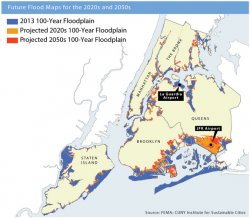Global warming, New York
 The city of New York — America's largest metropolis and home to over 8 million people — will be ravaged by the effects of climate change within a few years.
The city of New York — America's largest metropolis and home to over 8 million people — will be ravaged by the effects of climate change within a few years.
That's the bleak scenario presented by a recent 430-page report developed by a blue-ribbon panel of academics, environmental planners and government officials.
Released this month, the report, nicknamed "SIRR" for Special Initiative for Rebuilding and Resiliency, presents an ambitious plan for managing the worst effects of global warming, which include flooding, rising temperatures and extreme storms. [8 Ways Global Warming Is Already Changing the World]
The potential disasters laid out by the plan, however, could easily overwhelm New York City: Searing heat waves, pounding rainstorms and vast acreages flooded by seawater are all expected for the city and the surrounding region.
And as dire as these situations are for New York City as a whole, the implications for the city's most vulnerable populations — the elderly, children, disabled people and those with special needs — are even more ominous.
Sandy: a harbinger of storms to come
In addition to causing nearly $20 billion in damage, the storm killed 43 people and injured many more. The city's transportation facilities, including airports, commuter trains, subways and highways, were effectively shut down. [On the Ground: Hurricane Sandy in Images]
Other critical infrastructure, such as hospitals and wastewater treatment plants, were incapacitated, and millions of city residents were thrown into darkness by the flooding of electrical facilities. Communication networks were similarly crippled as personal cellphones, computer screens and other devices went dead.
Experts are quick to point out that Hurricane Sandy cannot be directly blamed on climate change, but say that similar storms are more likely in the near future, based on existing trends.
"There has been an increase in the strength of hurricanes, and in the number of intense hurricanes, in the North Atlantic since the early 1980s, " Cynthia Rosenzweig, a NASA researcher and co-chair of the New York City Panel on Climate Change (NPCC), said at a recent news briefing.
And Sandy's devastation was made worse by existing climate realities. "Sea level rise already occurring in the New York City area, in part related to climate change, increased the extent and magnitude of coastal flooding during the storm, " according to a 2013 NPCC document.
New York's future laid bare
After Sandy exposed New York's vulnerability to the impacts of climate change, Mayor Michael Bloomberg was emboldened to create the plan outlined in the recent SIRR report.
Among the report's many projections, written in a detached academic tone, are a number of genuinely frightening scenarios. A handful stand out as extreme events, said Rosenzweig, who refers to them as "the Big Three":
Heat waves: In decades past, New York experienced an average of 18 days a year with temperatures at or above 90 degrees Fahrenheit (32 degrees Celsius). But the city could experience 26 to 31 such days by 2020 — just seven years from now.
 The politics of global warming have involved corporate lobbying, funding of special interest groups and public relations campaigns by the oil and coal industries which have affected policy decisions and legislation worldwide. In turn this has caused political debate over the science of and response to global warming.
The politics of global warming have involved corporate lobbying, funding of special interest groups and public relations campaigns by the oil and coal industries which have affected policy decisions and legislation worldwide. In turn this has caused political debate over the science of and response to global warming.